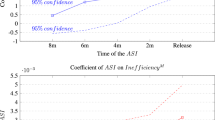Abstract
This article represents the first empirical attempt to detect the relationship between sales price and listing (or contract) period. Specifically, we examine the relationship between sales price and contract expiration days. Our hypothesized positive relationship between sales price and contract expiration days is borne out by the results of this study. These results show that the home seller is able to exact a price premium of 0.04% per contract day that he/she is able to preserve. Alternatively stated, he/she will concede a price discount of 0.04% per day, on average, as the sales contract approaches its expiration. Simple analyses of time on the market (TOM) without controlling for listing period may yield misleading signals.
Similar content being viewed by others
References
Allen, P. R., J. D. Shilling, and C. F. Sirmans. (1987). “Contracting, Contingencies and Single-Family House Prices,” Economic Inquiry 25 (January), 159–164.
Asabere, P. K., and F. E. Huffman. (1993). “Price Concessions, Time on the Market, and the Actual Sales Price of Homes,” Journal of Real Estate Finance and Economics 6, 167–174.
Asabere, P. K., and F. E. Huffman. (1993). “The Impact of Settlement Period on Sales Price,” Journal of Real Estate Finance and Economics, 7, 213–219.
Belkin, J., D. J. Hempel, and D. W. McLeavey. (1976). “An Empirical Study of Time on Market Using Multi-dimensional Segmentation of Housing Markets,” AREUEA Journal 4 (Fall), 57–75.
Colwell, P. F., and C. F. Sirmans. (1978). “Area, Time Centrality and the Value of Urban Land,” Land Economics 54, 514–519.
Crether, D. M., and P. Mieszkowski. (1974). “Determinants of Real Estate Values.” Journal of Urban Economics (April), 127–146.
Cronin, F. J. (1982). “The Efficiency of Housing Search,” Southern Economic Journal 48(4), 1016–1030.
Cubbins, J. S. (1974). “Price, Quality and Selling Time in the Housing Market,” Applied Economics 6, 171–187.
Dasso, J., and A. A. Ring. (1989). Real Estate Principles and Practices, 11th ed. Englewood Cliffs, NJ: Prentice Hall.
Ferreira, E. J., and G. S. Sirmans. (1989). “Selling Price, Financing Premiums and Days on the Market,” The Journal of Real Estate Finance and Economics 2 (September), 209–222.
Haurin, D. (1988). “The Duration of Marketing Time of Residential Housing,” AREUEA Journal 16 (4), 396–410.
Kalra, R., and K. C. Chan. (1994). “Censured Sample Bias, Macroeconomic Factors, and Time on Market of Residential Housing,” The Journal of Real Estate Research 9, 253–262.
King, A. T. (1973). Property Taxes, Amenities, and Residential Land Values. Cambridge, MA: Ballinger Publishing Co.
Kowalski, J. G., and P. F. Colwell. (1986). “Market Versus Assessed Values of Industrial Land,” AREUEA Journal 14, 361–373.
Larsen, J. E., and W. J. Park. (1989). “Non-Uniform Percentage Brokerage Commissions and Real Estate Market Performance,” AREUEA Journal 17 (4), 423–438.
Lippman, S. A., and J. J. McCall. (1986). “An Operational Measure of Liquidity,” American Economic Review 76, 1, 43–55.
Miller, N. G. (1977). “The Influence of Market Transaction Phenomena on Residential Property Values.” Unpublished doctoral dissertation, The Ohio State University.
Miller, N. G. (1978). “Time on the Market and Selling Price,” AREUEA Journal 6 (Summer), 164–174.
Miller, N. G., and M. A. Sklarz. (1987). “Pricing Strategies and Residential Property Selling Prices,” The Journal of Real Estate Research 2 (1), 31–40.
Rosen, S. (1974). “Hedonic Prices and Implicit Markets: Product Differentiation in Pure Competition,” Journal of Political Economy (January/February), 35–55.
Trippi, R. R. (1977). “Estimating the Relationship Between Price and Time of Sale for Investment Property,” Management Science 23 (April), 838–842.
Wheaton, W. C. (1990). “Vacancy, Search, and Prices in a Housing Market Matching Model,” Journal of Political Economy 96, 6, 1270–1292.
Yavas, A. (1992). “A Simple Search and the Bargaining Model of Real Estate Markets,” AREUEA Journal 20, 4, 533–548.
Author information
Authors and Affiliations
Rights and permissions
About this article
Cite this article
Asabere, P.K., Huffman, F.E. & Johnson, R.L. Contract expiration and sales price. J Real Estate Finan Econ 13, 255–262 (1996). https://doi.org/10.1007/BF00217394
Issue Date:
DOI: https://doi.org/10.1007/BF00217394




